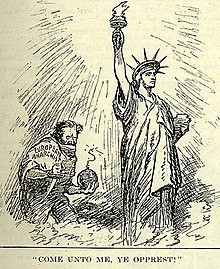Anarchism and violence
| Part of a series on |
| Anarchism |
|---|
 |
Anarchism and violence have been linked together by events in
Many anarchists regard the state to be at the definitional center of structural violence: directly or indirectly preventing people from meeting their basic needs, calling for violence as self-defense.[a]
Perhaps the first anarchist periodical was named
Propaganda of the deed

Late in the 19th century,
In this climate, some anarchists began to advocate and practice terrorism or assassination, which they referred to as propaganda of the deed. In many cases, newspapers blamed anarchist terrorism on immigrant naïveté, but scholar Richard Bach Jensen explained that "the emigrant experience may have heightened a pre-existing radicalism or given more precise configuration to its violent expression."[2]
Anarcho-pacifism

Anarcho-pacifism (also pacifist anarchism or anarchist pacifism) is a form of anarchism which completely rejects the use of violence in any form for any purpose. Important proponents include
Henry David Thoreau, though not a pacifist himself,[3] influenced both Leo Tolstoy and Mohandas Gandhi's advocacy of Nonviolent resistance through his work Civil Disobedience.[4]
At some point anarcho-pacifism had as its main proponent
"Dutch anarchist-pacifist Bart de Ligt's 1936 treatise The Conquest of Violence (with its none too subtle allusion to Kropotkin's The Conquest of Bread) was also of signal importance."[5] "Gandhi's ideas were popularized in the West in books such as Richard Gregg's The Power of Nonviolence (1935), and Bart de Ligt's The Conquest of Violence (1937). Peter Gelderloos criticizes the idea that nonviolence is the only way to fight for a better world. According to Gelderloos, pacifism as an ideology serves the interests of the state.[6]
Anarchist theory
Anarchism encompasses a variety of views about violence. The
Odonianism is anarchism. Not the bomb-in-the-pocket stuff, which is terrorism, whatever name it tries to dignify itself with, not the social-Darwinist economic 'libertarianism' of the far right; but anarchism, as prefigured in early Taoist thought, and expounded by Shelley and Kropotkin, Goldman and Goodman. Anarchism's principal target is the authoritarian State (capitalist or socialist); its principle moral-practical theme is cooperation (solidarity, mutual aid). It is the most idealistic, and to me the most interesting, of all political theories.[7]
Emma Goldman included in her definition of Anarchism the observation that all governments rest on violence, and this is one of the many reasons they should be opposed. Goldman herself didn't oppose tactics like assassination in her early career, but changed her views after she went to Russia, where she witnessed the violence of the Russian state and the Red Army. From then on she condemned the use of terrorism, especially by the state, and advocated violence only as a means of self-defense.
Discourse on violent and non-violent means
Some anarchists see violent revolution as necessary in the abolition of capitalist society, while others advocate non-violent methods.
It is our aspiration and our aim that everyone should become socially conscious and effective; but to achieve this end, it is necessary to provide all with the means of life and for development, and it is therefore necessary to destroy with violence, since one cannot do otherwise, the violence that denies these means to the workers.[9]
Anarchists with this view advocate violence insofar as they see it to be necessary in ridding the world of exploitation, and especially states.
Other anarchists have believed that violence is justified, especially in self-defense, as a way to provoke social upheaval which could lead to a social revolution.
Notes
- ^ See also: Right of self-defense
References
- ^ Fowler, R.B. The Western Political Quarterly, Vol. 25, No. 4. (Dec. 1972), pp. 743-744
- S2CID 142633873.
- ISBN 0521476755.
- ^ a b c ""Resiting the Nation State, the pacifist and anarchist tradition" by Geoffrey Ostergaard". Archived from the original on 2011-05-14. Retrieved 2010-03-08.
- ^ ""Anarchism and the Movement for a New Society: Direct Action and Prefigurative Community in the 1970s and 80s" by Andrew Cornell". Archived from the original on May 18, 2013.
- ISBN 9780896087729.
- Paul Goodman 1911-1972'), published in the anthology 'The Wind's Twelve QuartersVol2'
- ^ "The revolutionary haste by Errico Malatesta". Archived from the original on 2003-02-10. Retrieved 2003-01-11.
- ^ Umanità Nova, n. 125, September 6, 1921. A translation can be found at The revolutionary haste by Errico Malatesta. Retrieved June 17, 2006.
- ^ Goldman, Emma. 'Anarchism and Other Essays' Mother Earth (1910) p. 113.
- ^ Anarchism: A History of Libertarian Ideas and Movements.
- Tolstoyanismand to pacifist anarchism that appeared, mostly in Holland, Britain, and the United states, before and after the Second World War and which has continued since then in the deep in the anarchist involvement in the protests against nuclear armament."
Further reading
- Forman, James (1975). Anarchism: Political Innocence or Social Violence?. New York: F. Watts. ISBN 0-531-02790-2.
- Hubac-Occhipinti, Olivier (2007). "Anarchist Terrorists of the Nineteenth Century". In Chaliand, Gérard; Blin, Arnaud (eds.). The History of Terrorism: From Antiquity to Al Qaeda. Berkeley: University of California Press. ISBN 978-0-520-24533-4.
- Richards, Vernon (1983). Violence and Anarchism. London: ISBN 0-900384-70-0.
- ISBN 978-0-89608-772-9.
- ISBN 978-1-904859-18-5.
- You can't Blow up a Social Relationship: The Anarchist case against Terrorism. Australia: Anares Books. 1979.
- Wallis, Glenn (2022). "The Story of Anarchist Violence." The Anarchist Library.
